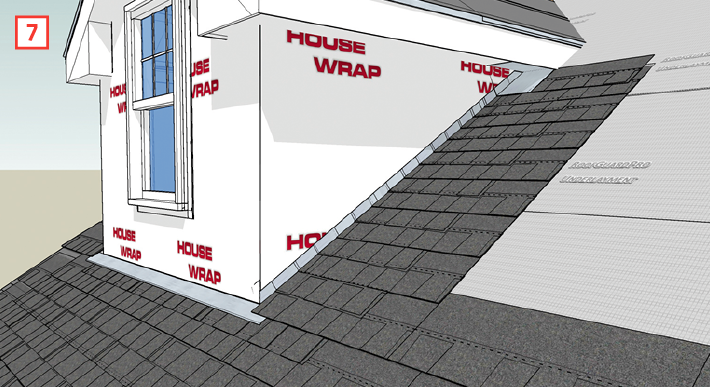The sketch above illustrates the end profile of roof drip edge flashing and shows its placement on the roof.
How far should flashing lay on roof.
Lay the second row of shingles.
Drip edge metal valley flashing dormer chimney and kickout flashing are types of roof flashing that shed water away from the connections between roofs walls chimneys and other building assemblies.
The flashing material should be 4 inches by 7 inches in length when it lies on the roof deck.
Second step flashing needs to extend 8 to 14 inches above the shingles according to the national roofing contractors association nrca.
Continuous flashing against a sidewall is one way to install a roof but it s not the correct way.
One common method is to lay the edge.
The 7 inch length ensures a 2 inch headlap on each course.
Also before you start installing your flashing you need to look to see if the wall in question has a corner on the roof face as in the image below.
Beginning at the outside edge of your roof place each panel directly onto the purlins that are attached to the roof trusses.
Usually you won t see much of drip edge as it s under the roof shingles under the underlayment and behind the roof gutter.
The second piece should not be fastened to the base so the two pieces can move against each other independently when the roofing materials shift.
Have a helper ready to assist with this step and take care to get the lines straight and clean.
After this lines should be snapped every 34 as you move up the roof.
This 1 2 tab has to be cut off where it hangs off the left edge of the gable roof.
Protect the eave from ice dams and sideways rain step one in steep slope roofing is the edge flashing.
Drip edges on the eaves any valley liners and all flashing should be installed before the tar paper is laid.
Set the first shingle of the second row back a half tab 6 inches 17 centimeters from the edge of first shingle on the first row and so that the bottom of its tabs just touches the tops of the cutout slots on the shingle below.
If it does follow our first installation procedure.
Recommended procedures of basic valley flashing installation.
Once complete the housewrap should overlap the step flashing that s applied to the wall.
Once even a small section of roofing cement fails you ll have a leak.
But it doesn t work that way.
It may seem as if a single piece of flashing would offer more protection than many pieces of step flashing.
Chalk lines should be snapped 33 5 8 above the eave line.
Two part flashing systems consist of a base flashing often step flashing that is laced into the finished roof material.
The base is then covered by another metal flashing piece lapped over it.
Then install a non corrosive metal valley flashing of 24 minimum width lap successive sheets of metal flashing a minimum of 12 inches and seal laps.
Next pre drill holes on the end and side ridges of the panels spacing the holes 6 to 8 inches apart.
Install an underlayment centered in the roof valley.

